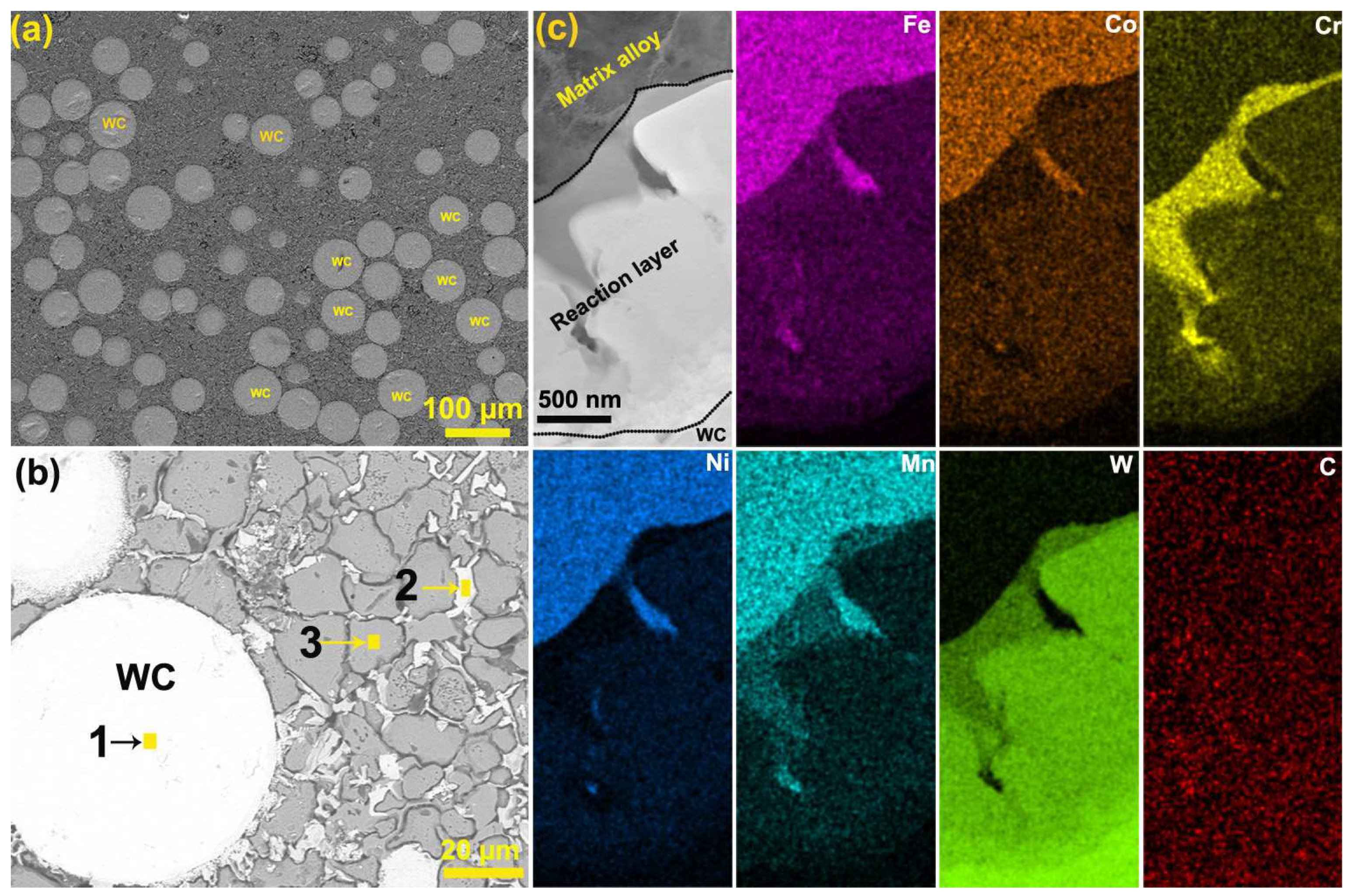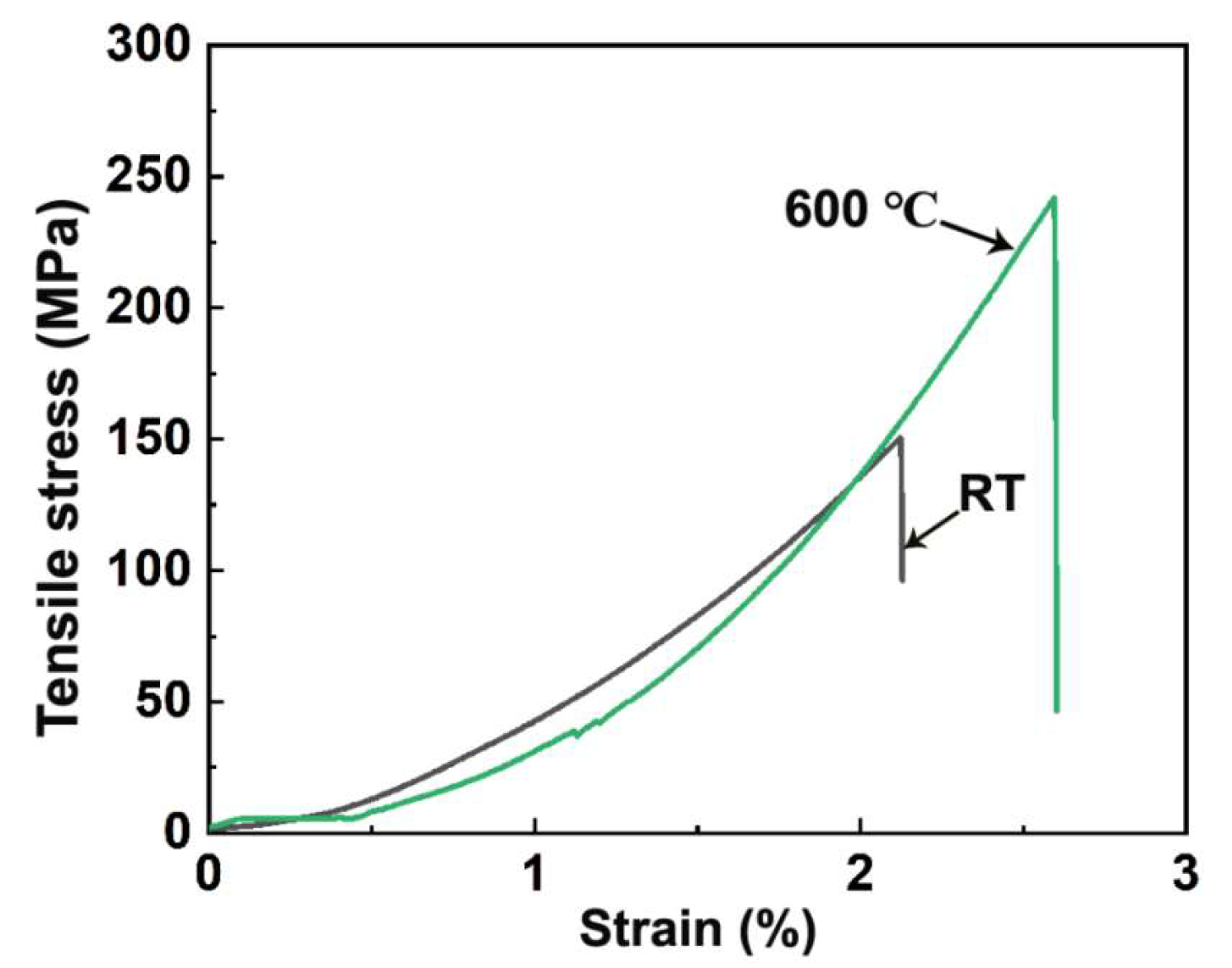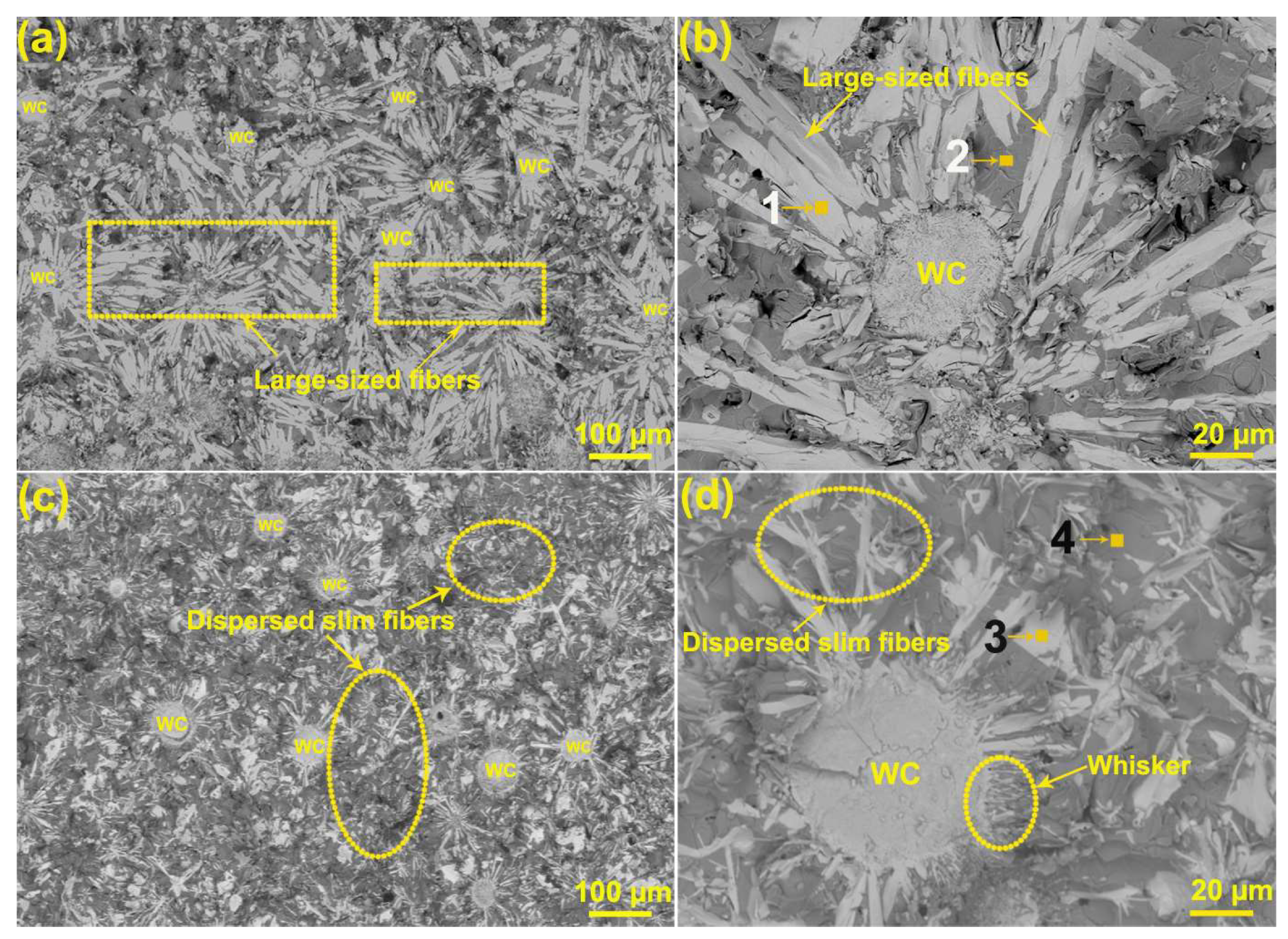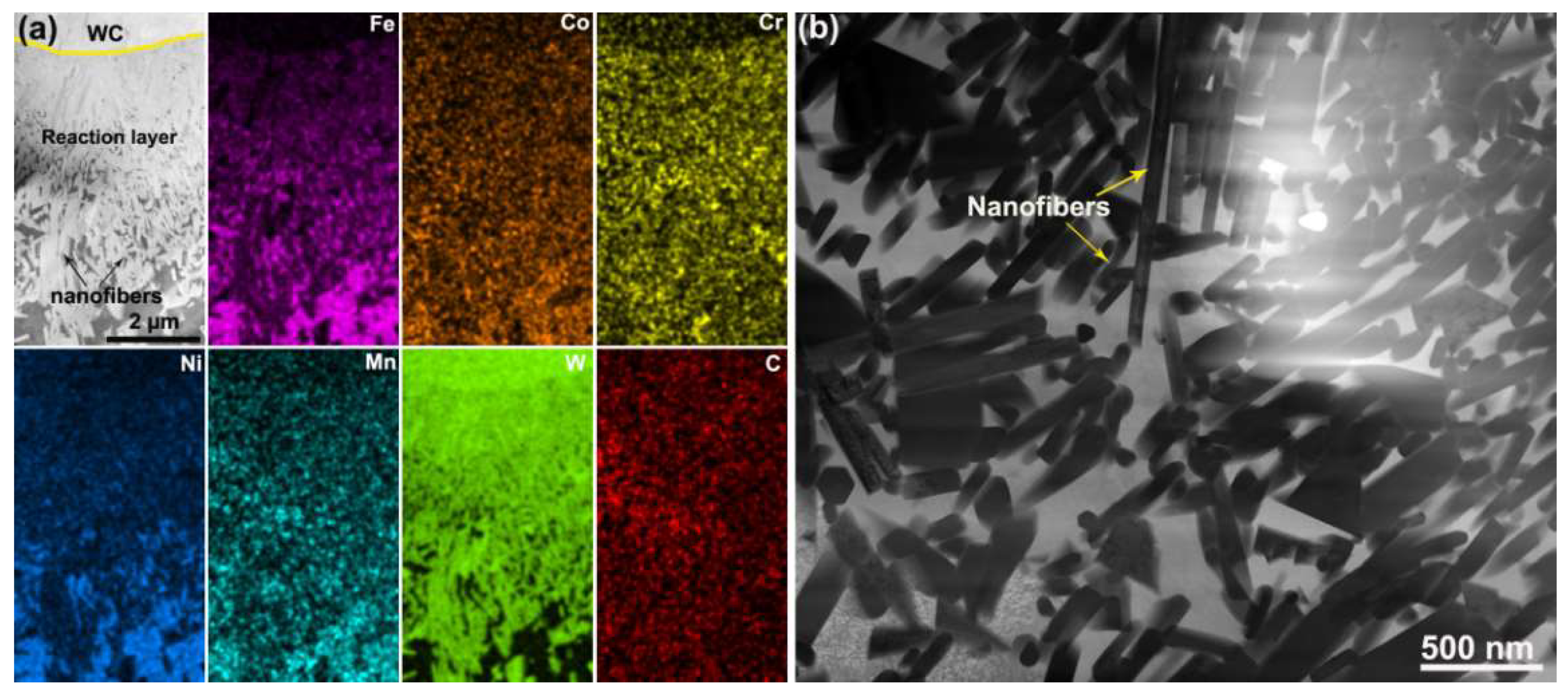Understanding the Fracture Failure Mechanism of WC Particle-Reinforced FeCoCrNiMn High-Entropy Alloy Coatings at 600 °C
Abstract
:1. Introduction
2. Materials and Methods
3. Results and Discussion
4. Conclusions
Author Contributions
Funding
Institutional Review Board Statement
Informed Consent Statement
Data Availability Statement
Acknowledgments
Conflicts of Interest
References
- Akbari, M.K.; Baharvandi, H.R.; Shirvanimoghaddam, K. Tensile and fracture behavior of nano/micro TiB2 particle reinforced casting A356 aluminum alloy composites. Mater. Des. 2015, 66, 150–161. [Google Scholar] [CrossRef]
- Xie, Z.; Guo, F.; Huang, X.; Li, K.; Chen, Q.; Chen, Y.; Gong, F. Understanding the anti-wear mechanism of SiCp/WE43 magnesium matrix composite. Vacuum 2020, 172, 109049. [Google Scholar] [CrossRef]
- Tan, H.; Luo, Z.; Li, Y.; Yan, F.; Duan, R.; Huang, Y. Effect of strengthening particles on the dry sliding wear behavior of Al2O3-M7C3/Fe metal matrix composite coatings produced by laser cladding. Wear 2015, 324–325, 36–44. [Google Scholar] [CrossRef]
- Zhou, S.F.; Dai, X.Q. Laser induction hybrid rapid cladding of WC particles reinforced NiCrBSi composite coating. Appl. Surf. Sci. 2010, 256, 4708–4714. [Google Scholar] [CrossRef]
- Yu, T.; Deng, Q.L.; Zheng, J.F.; Dong, G.; Yang, J.G. Microstructure and wear behaviour of laser clad NiCrBSi+Ta composite coating. Surf. Eng. 2011, 28, 357–363. [Google Scholar] [CrossRef]
- He, L.; Tan, Y.F.; Wang, X.L.; Jing, Q.F.; Hong, X. Tribological properties of laser cladding TiB2 particles reinforced Ni-base alloy composite coatings on aluminum alloy. Rare Met. 2015, 34, 789–796. [Google Scholar] [CrossRef]
- Peng, Y.; Zhang, W.; Li, T.; Zhang, M.; Liu, B.; Liu, Y.; Wang, L.; Hu, S. Effect of WC content on microstructures and mechanical properties of FeCoCrNi high-entropy alloy/WC composite coatings by plasma cladding. Surf. Coat. Technol. 2020, 385, 125326. [Google Scholar] [CrossRef]
- Ren, H.; Chen, R.R.; Liu, T.; Gao, X.F.; Qin, G.; Wu, S.P.; Guo, J.J. Unraveling the oxidation mechanism of Y-doped AlCoCrFeNi high-entropy alloy at 1100 °C. Appl. Surf. Sci. 2024, 652, 159316. [Google Scholar] [CrossRef]
- Chuang, M.H.; Tsai, M.H.; Wang, W.R.; Lin, S.J.; Yeh, J.W. Microstructure and wear behavior of AlxCo1.5CrFeNi1.5Tiy high-entropy alloys. Acta Mater. 2011, 59, 6308–6317. [Google Scholar] [CrossRef]
- Zhang, W.; Zhang, M.Y.; Peng, Y.B.; Wang, L.; Liu, Y.; Hu, S.H.; Hu, Y. Interfacial structures and mechanical properties of a high entropy alloy-diamond composite. Int. J. Refract. Met. Hard Mater. 2020, 86, 105109. [Google Scholar] [CrossRef]
- Zhang, W.; Zhang, M.Y.; Peng, Y.B.; Liu, F.Z.; Liu, Y.; Hu, S.H.; Hu, Y. Effect of Ti/Ni coating of diamond particles on microstructure and properties of high-entropy alloy/diamond composites. Entropy 2019, 21, 164. [Google Scholar] [CrossRef] [PubMed]
- Peng, Y.B.; Zhang, W.; Li, T.C.; Zhang, M.Y.; Wang, L.; Song, Y.; Hu, S.H.; Hu, Y. Microstructures and mechanical properties of FeCoCrNi high entropy alloy/WC reinforcing particles composite coatings prepared by laser cladding and plasma cladding. Int. J. Refract. Met. Hard Mater. 2019, 84, 105044. [Google Scholar] [CrossRef]
- Nefedyev, S.P.; Vdovin, K.N.; Emelyushin, A.N. Peculiarities of forming of the wear-resistant cast iron coating structure on steel 45 upon plasma-powder surfacing. Mater. Sci. Forum 2016, 870, 141–148. [Google Scholar] [CrossRef]





| Name | Parameter Value |
|---|---|
| Welding current (A) | 150 |
| Powder feeding capacity (rad/min) | 40 |
| Protective gas flow rate (L/min) | 1 |
| Powder feeding gas flow rate (L/min) | 4 |
| Ion gas flow rate (L/min) | 2 |
| Welding speed (mm/min) | 170 |
Disclaimer/Publisher’s Note: The statements, opinions and data contained in all publications are solely those of the individual author(s) and contributor(s) and not of MDPI and/or the editor(s). MDPI and/or the editor(s) disclaim responsibility for any injury to people or property resulting from any ideas, methods, instructions or products referred to in the content. |
© 2024 by the authors. Licensee MDPI, Basel, Switzerland. This article is an open access article distributed under the terms and conditions of the Creative Commons Attribution (CC BY) license (https://creativecommons.org/licenses/by/4.0/).
Share and Cite
Wang, X.; Zhang, S.; Zhao, F.; Wu, Z.; Xie, Z. Understanding the Fracture Failure Mechanism of WC Particle-Reinforced FeCoCrNiMn High-Entropy Alloy Coatings at 600 °C. Coatings 2024, 14, 339. https://doi.org/10.3390/coatings14030339
Wang X, Zhang S, Zhao F, Wu Z, Xie Z. Understanding the Fracture Failure Mechanism of WC Particle-Reinforced FeCoCrNiMn High-Entropy Alloy Coatings at 600 °C. Coatings. 2024; 14(3):339. https://doi.org/10.3390/coatings14030339
Chicago/Turabian StyleWang, Xinbo, Shihan Zhang, Fei Zhao, Zhisheng Wu, and Zhiwen Xie. 2024. "Understanding the Fracture Failure Mechanism of WC Particle-Reinforced FeCoCrNiMn High-Entropy Alloy Coatings at 600 °C" Coatings 14, no. 3: 339. https://doi.org/10.3390/coatings14030339






